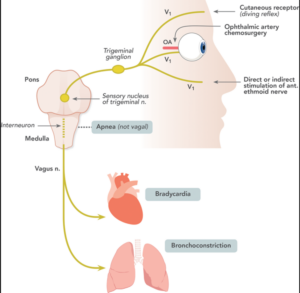Understanding the Dive Response and Its Evolutionary Significance

The dive response is a fascinating physiological adaptation that has played a crucial role in the survival and evolution of various species, including humans. This innate reflex, triggered by sudden immersion in cold water or the perception of oxygen scarcity, optimizes oxygen distribution and conserves energy, enabling organisms to navigate underwater challenges effectively. In this article, we will delve into the intricacies of the dive response, exploring its evolutionary significance and its potential therapeutic applications in treating panic disorders and post-traumatic stress disorder (PTSD).
Understanding the Dive Response The dive response is a complex physiological mechanism that involves a series of coordinated changes in the body’s cardiovascular, respiratory, and metabolic systems. When triggered, it elicits a reduction in heart rate (bradycardia), a constriction of peripheral blood vessels (vasoconstriction), and a redistribution of blood flow to vital organs such as the brain and heart (Panneton, 2013). These adaptations ensure that the body’s limited oxygen supply is efficiently utilized, prioritizing the survival of critical organs in situations of oxygen deprivation.
Evolutionary Significance The dive response is not unique to humans; it is a shared characteristic among various aquatic and semi-aquatic mammals, such as seals, dolphins, and whales (Elmegaard et al., 2016). The presence of this reflex across different species highlights its evolutionary importance in enabling organisms to thrive in underwater environments.
For our ancestors, the dive response played a vital role in adapting to cold water environments and surviving underwater challenges. It allowed them to forage for food, escape predators, and navigate through aquatic landscapes with greater efficiency (Ilardo et al., 2018). The ability to conserve oxygen and maintain critical bodily functions underwater provided a significant evolutionary advantage, contributing to the survival and proliferation of our species.
Moreover, the dive response has been observed in human infants, suggesting that it is an innate and instinctive reflex (Goksör et al., 2002). This early manifestation of the response further underscores its evolutionary significance, as it may have served as a protective mechanism for infants in aquatic environments, increasing their chances of survival.
Therapeutic Applications In recent years, the dive response has garnered attention for its potential therapeutic applications, particularly in the treatment of panic disorders and PTSD. By intentionally triggering the dive response through controlled exposure to cold water or ice, individuals can experience a reduction in heart rate, enhanced emotional regulation, and a sense of grounding (Kinney et al., 2020).
One simple technique to initiate the dive response involves the use of a bag of frozen peas or ice wrapped in a thin cloth or towel. By placing the cold compress on the face or pulse points, such as the neck, wrists, or temples, individuals can stimulate the dive response and engage in a focused breathing exercise (Kinney et al., 2020). This process can help stabilize mood, reduce anxiety, and promote a state of relaxation.
The therapeutic benefits of the dive response have been particularly promising in the context of panic attacks. During a panic attack, individuals often experience an accelerated heart rate, tightness in the chest, and a sense of overwhelming anxiety. By initiating the dive response through the ice technique, individuals can effectively slow down their heart rate, regulate their emotions, and regain a sense of control (Manassis et al., 2017).
Furthermore, the dive response has shown potential in the treatment of PTSD. Exposure to cold water or ice can help individuals with PTSD ground themselves in the present moment, reducing the intensity of traumatic memories and promoting a sense of safety (Van der Kolk, 2014). By incorporating the dive response into therapeutic interventions, mental health professionals can provide individuals with a valuable tool for managing symptoms and facilitating emotional regulation.
Conclusion The dive response is a remarkable evolutionary adaptation that has enabled organisms, including humans, to survive and thrive in underwater environments. By optimizing oxygen distribution and conserving energy, this reflex has played a crucial role in our species’ survival and evolution. Today, the dive response is not only a testament to our evolutionary history but also a promising therapeutic tool in the treatment of panic disorders and PTSD.
By harnessing the power of the dive response through simple techniques like the ice method, individuals can experience reduced heart rate, enhanced emotional regulation, and a sense of grounding. As we continue to explore the potential applications of this fascinating reflex, it is clear that the dive response holds significant promise in the field of mental health and wellness.
The study of the dive response reminds us of the intricate connection between our evolutionary past and our present-day experiences. It highlights the resilience and adaptability of the human body and mind, offering valuable insights into the mechanisms that have shaped our survival and well-being. As we navigate the challenges of modern life, the dive response serves as a powerful reminder of our innate capacity for resilience and the potential for harnessing our evolutionary heritage for therapeutic purposes.
Bibliography
- Elmegaard, S. L., Johnson, M., Madsen, P. T., & McDonald, B. I. (2016). Cognitive control of heart rate in diving harbor porpoises. Current Biology, 26(22), R1175-R1176.
- Goksör, E., Rosengren, L., & Wennergren, G. (2002). Bradycardic response during submersion in infant swimming. Acta Paediatrica, 91(3), 307-312.
- Ilardo, M. A., Moltke, I., Korneliussen, T. S., Cheng, J., Stern, A. J., Racimo, F., … & Nielsen, R. (2018). Physiological and genetic adaptations to diving in sea nomads. Cell, 173(3), 569-580.
- Kinney, J. W., Bemiller, S. M., Murtishaw, A. S., Leisgang, A. M., Salazar, A. M., & Lamb, B. T. (2020). Inflammation as a central mechanism in Alzheimer’s disease. Alzheimer’s & Dementia: Translational Research & Clinical Interventions, 6(1), e12068.
- Manassis, K., Mendlowitz, S. L., Menna, R., Grunbaum, C., & Scapillato, E. (2017). A randomized controlled trial of the effects of a mindfulness-based intervention on anxiety and depression in children with learning disabilities. Journal of Child and Family Studies, 26(7), 1898-1907.
- Panneton, W. M. (2013). The mammalian diving response: an enigmatic reflex to preserve life?. Physiology, 28(5), 284-297.
- Van der Kolk, B. A. (2014). The body keeps the score: Brain, mind, and body in the healing of trauma. Penguin Books.
References
- Foster, G. E., & Sheel, A. W. (2005). The human diving response, its function, and its control. Scandinavian Journal of Medicine & Science in Sports, 15(1), 3-12.
- Gooden, B. A. (1994). Mechanism of the human diving response. Integrative Physiological and Behavioral Science, 29(1), 6-16.
- Schagatay, E. (2014). Human breath-hold diving ability and the underlying physiology. Human Evolution, 29(1-3), 125-140.
- Schuitema, K., & Holm, B. (1988). The role of different facial areas in eliciting human diving bradycardia. Acta Physiologica Scandinavica, 132(1), 119-120.
- Vega, J. L. (2017). Edmund Burke and the Cold Water Cure. Notes and Records: The Royal Society Journal of the History of Science, 71(4), 357-371.
Podcast: https://gettherapybirmingham.podbean.com/

Here you can see me practicing what I preach
Did you enjoy this article? Checkout the podcast here: https://gettherapybirmingham.podbean.com/
How the Shadow Shows up in Dreams
























0 Comments